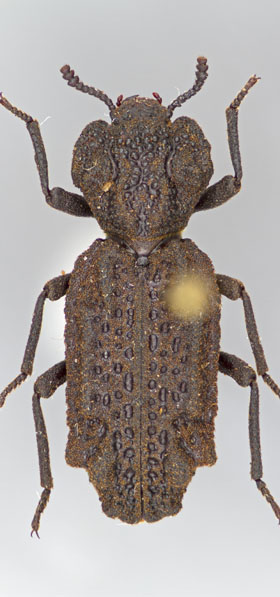 |
 Previous Genus Next Genus Previous Genus Next Genus 
Genus: Phellopsis
Diagnostic Features
- Description: Antennae 11-segmented with a 3-segmented club. Antennal setation sparse. Eyes well-developed, elongate-oval, somewhat reniform, coarsely faceted, extending well onto dorsal portion of head. Males with setose pit on submentum. Lateral margins of pronotum arcuate to sinuate, without distinct lobes. Pronotal disc with several depressions and numerous small, round tubercles. Hypomeron without depressions or antennal cavities. Prosternum without distinct transverse groove. Procoxal cavities narrowly open. Metacoxae widely separated, separation as wide or wider than metacoxal length. Scutellum small, visible. Abdominal ventrite 5 with a deep preapical groove divided medially into two setose depressions. Tarsal formula 5-5-4. Dorsal surface granulose, tomentose. Dorsal and ventral surfaces commonly encrusted with dirt and debris.
- Similar genera: The genus Phellopsis is similar to the genera Sesaspis, Phloeodes, and Zopherus, but can immediately be distinguished by the 11-segmented antennae with a 3-segmented club, narrowly open procoxal cavities, hypomeron with lack of depression/antennal cavity, and a small but visible scutellum.
Known Distribution
- Southwest (CA, NV), Northwest (AK, ID, MT, OR, WA), Northeast (CT, MA, ME, MD, NH, NJ, NY, PA, VA, VT, WV), North Central (MI, WI), Southeast (GA, NC, TN) USA; Alberta, British Columbia, New Brunswick, Newfoundland, Nova Scotia, Ontario, Quebec, Canada.
Biology
- Phellopsis feeds on fungus found in old growth boreal forests. P. obcordata have been reported to feed on Piptoporus betulinus (Polyporales) on birch (Betula papyrifera, B. lenta) and Heterobasidion annosum (Bondarzewiaceae) on balsam fir (Abies balsamea). P. porcata have been reported to feed on fungi on western hemlock (Tsuga heterophylla) and on Lentinus (Polyporaceae).
- Abundance: moderately common.
North American Species (2)
Species Diagnoses
- Phellopsis obcordata: Eastern species. Hypomeron lacking dense setation in between tubercles. Distribution: Connecticut, Georgia, Massachusetts, Maryland, Maine, Michigan, North Carolina, New Hampshire, New Jersey, New York, Pennsylvania, Tennessee, Virginia, Vermont, Wisconsin, West Virginia, USA, New Brunswick, Newfoundland, Nova Scotia, Ontario, Quebec, Canada.
- Phellopsis porcata: Western species. Hypomeron with dense setation in between tubercles. Distribution: California, Nevada, Alaska, Idaho, Montana, Oregon, Washington, USA; Alberta, British Columbia, Canada.
Discussion
- The taxonomic history of this genus in North America is quite complex, but following the thorough revision by Foley and Ivie (2008), only two species are currently recognized.
Potential Problems with Identification
- Members of this genus are frequently encrusted with dirt and other debris which may conceal the diagnostic characters.
Selected References
|
 |
 
Phellopsis obcordata
© N.P. Lord |


